Practice Question - 73 (Quant Based) | 100 DILR Questions for CAT Preparation PDF Download
An air conditioner (AC) company has four dealers - D1, D2, D3 and D4 in a city. It is evaluating sales performances of these dealers. The company sells two variants of ACs - Window and Split. Both these variants can be either Inverter type or Non-inverter type. It is known that of the total number of ACs sold in the city, 25% were of Window variant, while the rest were of Split variant. Among the Inverter ACs sold, 20% were of Window variant.
The following information is also known:
- Every dealer sold at least two window ACs.
- D1 sold 13 inverter ACs, while D3 sold 5 Non-inverter ACs.
- A total of six Window Non-inverter ACs and 36 Split Inverter ACs were sold in the city.
- The number of Split ACs sold by D1 was twice the number of Window ACs sold by it.
- D3 and D4 sold an equal number of Window ACs and this number was one-third of the number of similar ACs sold by D2.
- D2 and D3 were the only ones who sold Window Non-inverter ACs. The number of these ACs sold by D2 was twice the number of these ACs sold by D3.
- D3 and D4 sold an equal number of Split Inverter ACs. This number was half the number of similar ACs sold by D2.
Q1: How many Split Inverter ACs did D2 sell?
 View Answer
View Answer 
Ans: 14
Let us assume, A is the total number of AC's sold
⇒ From the information that the total number of ACs sold in the city, 25% were of Window variant => Window AC's = A/4 and Split AC's = 3A/4
Now, let us assume B is the total number of inverter ACs
⇒ From the information that among the Inverter ACs sold, 20% were of Window variant.=> Window Inverter AC's = B/5 and Window Non
Inverter AC's = 4B/5
From - Condition-3:

⇒ A / 4 - B / 5 = 6 and 4B / 5 = 36 ⇒ B = 46 and A = 60.
 Now, from condition-6:
Now, from condition-6:
a) D1 & D4 sold "0" window Non-inverter ACs ⇒ D2 & D3 sold 6 window non-inverter ACs, it is given that D2 sold twice as many as D3 ⇒ D2 sold 4 and D3 sold 2 ACs of this type.
From condition-2:
b) Let us assume, D1 sold "x" window inverter ACs ⇒ Number of split inverter ACs sold is 13-x
From condition-4:
c) Number of split ACs sold by D1 will be "2x"
From condition-5:
d) Let us assume 'y' is the number of window ACs sold by D3 & D4 ⇒ D2 sold 3y ACs of this type.
From condition-7:
e) Let us assume 'z' is the number of split inverter ACs sold by D3 and D4 ⇒ D2 sold 2z ACs of this type.
Let us use a, b, c, d, and e make a table: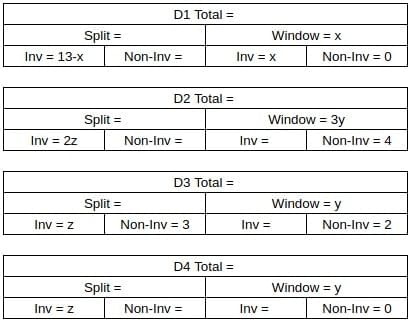 We know that the total number of window ACs is 15
We know that the total number of window ACs is 15
⇒ x + 3y + y + y = 15 ⇒ x + 5y = 15, also x and y should be greater than or equal to 2 from condition-1
⇒ x = 5 and y = 2 is the only solution.
Filling this in the table: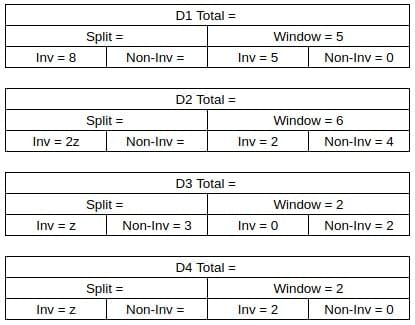 Now, Number of split inverter ACs is 36
Now, Number of split inverter ACs is 36
⇒ 8 + 2z + z + z = 36 ⇒ 4z = 28 ⇒ z = 7.
Filling this and using (5), the number of split AC's sold by D1 is 2*5 = 10.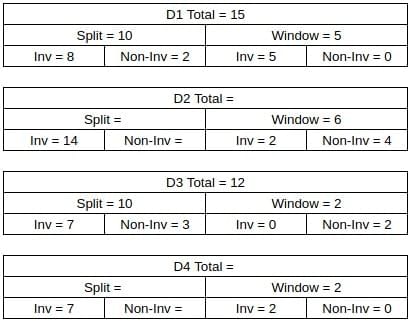
From the table, we see that 14 split inverter ACs are sold.
Q2: Which of the following statements is necessarily false?
(a) D2 sold the highest number of ACs.
(b) D4 sold more Split ACs as compared to D3.
(c) D1 and D3 sold an equal number of Split ACs.
(d) D1 and D3 together sold more ACs as compared to D2 and D4 together.
 View Answer
View Answer 
Ans: (d)
Let us assume, A is the total number of AC's sold
⇒ From the information that the total number of ACs sold in the city, 25% were of Window variant => Window AC's = A/4 and Split AC's = 3A/4
Now, let us assume B is the total number of inverter ACs
⇒ From the information that among the Inverter ACs sold, 20% were of Window variant.=> Window Inverter AC's = B/5 and Window Non
Inverter AC's = 4B/5
From - Condition-3

⇒ A / 4 - B / 5 = 6 and 4B / 5 = 36 ⇒ B = 46 and A = 60.
 Now, from condition-6
Now, from condition-6
a) D1 & D4 sold "0" window Non-inverter ACs ⇒ D2 & D3 sold 6 window non-inverter ACs, it is given that D2 sold twice as many as D3 ⇒ D2 sold 4 and D3 sold 2 ACs of this type.
From condition-2
b) Let us assume, D1 sold "x" window inverter ACs ⇒ Number of split inverter ACs sold is 13-x
From condition-4
c) Number of split ACs sold by D1 will be "2x"
From condition-5
d) Let us assume 'y' is the number of window ACs sold by D3 & D4 ⇒ D2 sold 3y ACs of this type.
From condition-7
e) Let us assume 'z' is the number of split inverter ACs sold by D3 and D4 ⇒ D2 sold 2z ACs of this type.
Let us use a, b, c, d, and e make a table: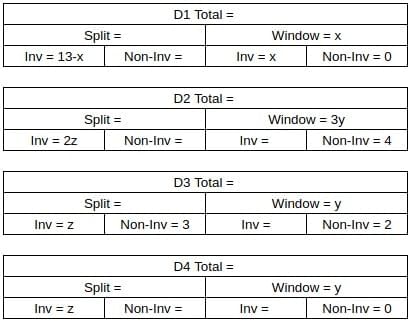 We know that the total number of window ACs is 15
We know that the total number of window ACs is 15
⇒ x + 3y + y + y = 15 ⇒ x + 5y = 15, also x and y should be greater than or equal to 2 from condition-1
⇒ x = 5 and y = 2 is the only solution.
Filling this in the table: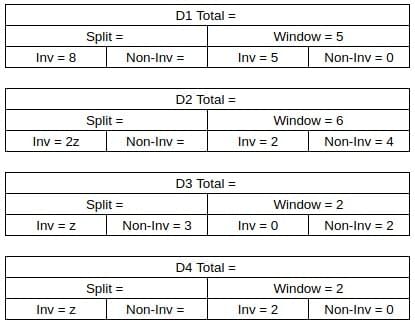 Now, Number of split inverter ACs is 36
Now, Number of split inverter ACs is 36
⇒ 8 + 2z + z + z = 36 ⇒ 4z = 28 ⇒ z = 7.
Filling this and using (5), the number of split AC's sold by D1 is 2*5 = 10.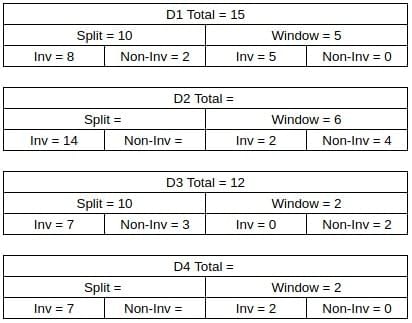
We see that D1 & D3 sold 27 ACs together which is less than 60 - 27 = 33 sold by D2 & D4.
⇒ Option-D is definitely false.
Q3: If D3 and D4 sold an equal number of ACs, then what was the number of Non-inverter ACs sold by D2?
(a) 4
(b) 5
(c) 7
(d) 6
 View Answer
View Answer 
Ans: (b)
Let us assume, A is the total number of AC's sold
⇒ From the information that the total number of ACs sold in the city, 25% were of Window variant => Window AC's = A/4 and Split AC's = 3A/4
Now, let us assume B is the total number of inverter ACs
⇒ From the information that among the Inverter ACs sold, 20% were of Window variant.=> Window Inverter AC's = B/5 and Window Non
Inverter AC's = 4B/5
From - Condition-3

⇒ A / 4 - B / 5 = 6 and 4B / 5 = 36 ⇒ B = 46 and A = 60.
 Now, from condition-6
Now, from condition-6
a) D1 & D4 sold "0" window Non-inverter ACs ⇒ D2 & D3 sold 6 window non-inverter ACs, it is given that D2 sold twice as many as D3 ⇒ D2 sold 4 and D3 sold 2 ACs of this type.
From condition-2
b) Let us assume, D1 sold "x" window inverter ACs ⇒ Number of split inverter ACs sold is 13-x
From condition-4
c) Number of split ACs sold by D1 will be "2x"
From condition-5
d) Let us assume 'y' is the number of window ACs sold by D3 & D4 ⇒ D2 sold 3y ACs of this type.
From condition-7
e) Let us assume 'z' is the number of split inverter ACs sold by D3 and D4 ⇒ D2 sold 2z ACs of this type.
Let us use a, b, c, d, and e make a table: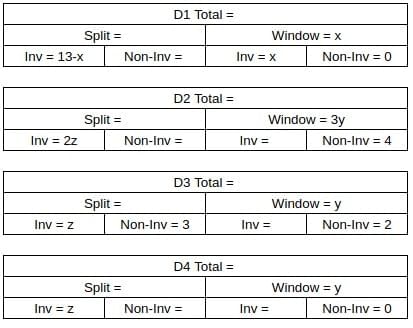 We know that the total number of window ACs is 15
We know that the total number of window ACs is 15
⇒ x + 3y + y + y = 15 ⇒ x + 5y = 15, also x and y should be greater than or equal to 2 from condition-1
⇒ x = 5 and y = 2 is the only solution.
Filling this in the table: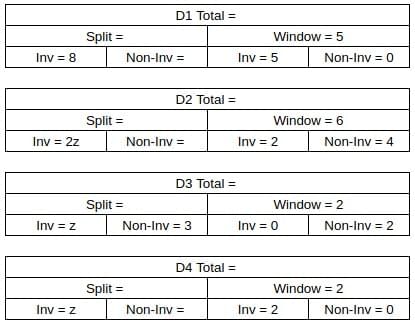 Now, Number of split inverter ACs is 36
Now, Number of split inverter ACs is 36
⇒ 8 + 2z + z + z = 36 ⇒ 4z = 28 ⇒ z = 7.
Filling this and using (5), the number of split AC's sold by D1 is 2 * 5 = 10.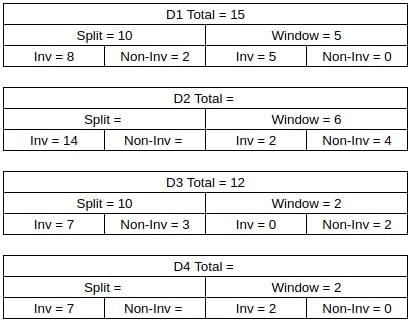
If D3 and D4 sold equal number of AC's, the table will look as follows: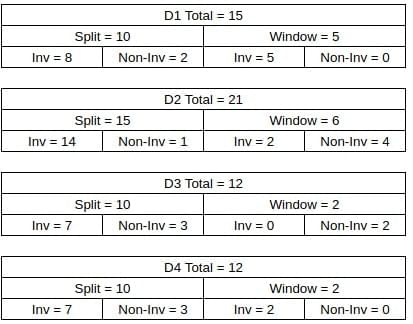
Number of non-inverter ACs sold is 1 + 4 = 5.
|
102 videos|123 docs|121 tests
|
FAQs on Practice Question - 73 (Quant Based) - 100 DILR Questions for CAT Preparation
| 1. What is the format of the Quantitative Aptitude section in the CAT exam? |  |
| 2. What types of topics should one focus on while preparing for the Quant section of the CAT exam? |  |
| 3. How important is time management during the Quantitative Aptitude section of the CAT exam? |  |
| 4. Are there any recommended resources for preparing for the Quantitative Aptitude section of the CAT exam? |  |
| 5. What strategies can help improve performance in the Quantitative Aptitude section of the CAT exam? |  |















